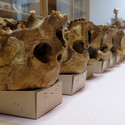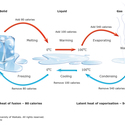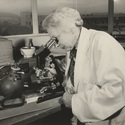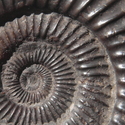Dinosaurs used to live in New Zealand. We know this because their fossils have been found in a few places. The fossils of a number of different dinosaurs were found at the Mangahouanga Stream, in north-west Hawke’s Bay, by Joan Wiffen and her colleagues. They were found together with fossils of land plants, including pollen1 from trees and tree ferns, as well as with fossil2 marine animals.
The remains of dead land animals and plants were probably washed down a river and into a shallow bay, where they mixed with the remains of dead marine animals. This material was compressed together with sediments3 into a sandstone4 rock. The fossils and rock tell us about what lived in prehistoric Hawke’s Bay and what the environment was like.
To add to the picture of prehistoric Hawke’s Bay, paleontologists have tried to find out when the Mangahouanga fossils lived. These include Dr James Crampton and colleagues at GNS Science and others at Victoria University of Wellington.
Relative dating
James and the other paleontologists used relative dating first, which looks at where rocks fit in a sequence. The sandstone containing the fossils is above a layer of late Jurassic5 greywacke6 and under a layer of late Cretaceous7 mudstone8. The sandstone and its fossils are therefore from a time somewhere in between, so all that could be said was that the fossils were from the Cretaceous period, which lasted for 80 million years.
Fossil correlation
The next dating technique was fossil correlation9. Large fossil clams found at Mangahouanga were compared to fossils in rocks at other places that had already been dated. The evidence10 pointed towards the fossils being from the Piripauan and Haumurian stages of the late Cretaceous. This narrowed the dates of the Mangahouanga fossils down to a 20 million year range.
To narrow the dating down further, more correlation was done using microfossils found alongside the larger fossils. The microfossils that James and others study are single-celled marine organisms called dinoflagellates11. Part of the dinoflagellate12 life cycle has a resistant case that survives well as a fossil.
Dinoflagellate fossils around the world have been studied in deep-sea cores that contain rock records going back many millions of years. The times when different species13 appeared and then became extinct have been dated using paleomagnetism14 and radiometric methods. Dinoflagellate fossils found at Mangahouanga were compared to this worldwide reference material.
Several pieces of rock from Mangahouanga, each containing a dinosaur or marine reptile15 fossil, were examined by scientists Martin Young and Michael Hannah. The rock was broken down using hydrofluoric acid16, leaving the resistant dinoflagellate fossils. The species were identified using a microscope17 and then compared to species known and dated in deep-sea cores.
One rock contained a mosasaur18 fossil alongside the dinoflagellate species Satyrodinium haumuriense and Vozzhennikovia spinulosa. These species lived together between 77 and 81 million years ago in the lower Haumurian stage, so we can say that the mosasaur lived at some time in this 4 million year period too.
The two rocks with dinosaur fossils only had a single dinoflagellate species each. This meant that the result was not so precise. One dinosaur fossil was found with the dinoflagellate Odontochitina porifera. This lived right from the Piripauan through to the middle of the upper Haumurian – a period of 16 million years. The other dinosaur fossil was associated with the dinoflagellate Odontochitina spinosa, which lived from the mid-lower Haumurian onwards.
Related content
Read about some dinosaur fossil discoveries in New Zealand
- World’s largest known dinosaurs once roamed New Zealand
- Ancient dinosaur footprints discovered near Nelson
Activity ideas
Fossil correlation – students date fossils from one site by matching them to fossils already dated somewhere else, using real data19 from Mangahouanga, made famous by paleontologist20 Joan Wiffen.
Big numbers in science – investigate the use of big numbers, such as millions and billions, and they encounter ways to understand what these big numbers mean.
Which dating method? – learn to recognise some of the different relative and absolute dating21 methods.
Useful link
See the Otago Museum Fossils learning bundle – linked to levels 1–5 of the New Zealand curriculum, it includes worksheets, video activities and crafts to make cross-curricular links.
Explore research from around the world under The Conversation dinosaur topic.
- pollen: Dust-like grains that contain male sex cells (gametes) of flowering plants (angiosperms) and cone plants (gymnosperms). Pollen is made on the anthers of flowering plants.
- fossil: The remains or imprint of an organism preserved in some manner. Typically fossils are found in sedimentary rock as a result of mineral replacement or imprinting in once soft silt or sand layers. Normally, rock fossils only include the hard parts of an organism such as the skeleton or shell. Fossils can also include the original remains (including soft tissue) preserved in amber, pitch or ice, or preserved in ‘fossil layers’ in special sheltered cave environments.
- sediments: Material that settles to the bottom of a liquid. In geology, it describes the solid fragments of inorganic or organic material that come from the weathering of rock and are carried and deposited by wind, water or ice.
- sandstone: A sedimentary rock formed from grains of sand (0.1–2.0 mm in size) held together by a natural cement. Sandstone can be formed under water or from wind-blown sand on land.
- Jurassic: The geological period between Triassic and Cretaceous. It lasted from about 200 million years ago until 146 million years ago. Worldwide, dinosaurs were common, and the first birds appeared.
- greywacke: A sedimentary rock that forms much of the backbone of New Zealand. Made mainly of the minerals quartz and feldspar, with fragments of other rocks, greywacke is mostly like dark sandstone, but also contains mudstone.
- Cretaceous: The third and last geological time period in the Mesozoic era, from 140 million to 65 million years ago. This time period is marked by the main development and subsequent extinction of The third and last geological period of the Mesozoic era. It lasted from 145 to 65 million years ago.
- mudstone: A fine-grained sedimentary rock formed from a mixture of clay and silt. (Silt particles are larger than clay particles.)
- correlation: (Noun) A relationship between two things, for example, doing exercise and your heart rate increasing.
(Verb) To find a relationship between two things. For example, in geology, correlation involves trying to match rocks or fossils of the same age between different locations. - evidence: Data, or information, used to prove or disprove something.
- dinoflagellate: Microscopic single-celled organism that lives in freshwater and seawater. Under warm conditions, marine species can grow and spread to cause a red ‘bloom’ visible in the sea.
- dinoflagellate: Microscopic single-celled organism that lives in freshwater and seawater. Under warm conditions, marine species can grow and spread to cause a red ‘bloom’ visible in the sea.
- species: (Abbreviation sp. or spp.) A division used in the Linnean system of classification or taxonomy. A group of living organisms that can interbreed to produce viable offspring.
- paleomagnetism: Changes in the Earth’s magnetic field recorded by the way magnetic minerals lined up in rocks as they were formed.
- reptile: A class of animals that includes snakes, lizards, alligators, crocodiles, tortoises and turtles.
- hydrofluoric acid: One of the strongest inorganic acids. It is very corrosive, and geologists use it to break down rock samples. It also attacks glass so is stored in plastic containers.
- microscope: An instrument that uses a lens or a series of lenses to magnify small objects.
- mosasaur: An extinct type of marine reptile that lived in the Cretaceous period. They looked something like a huge crocodile, with paddles instead of legs. Many different species lived in the sea around New Zealand.
- data: The unprocessed information we analyse to gain knowledge.
- paleontologist: Someone who studies fossils of plants and animals.
- absolute dating: Finding the actual dates of geological or archaeological objects. Normally expressed as calendar years ago.








